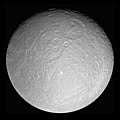चित्र:PIA07763 Rhea full globe5.jpg

मूल फ़ाइल ((४,९२० × ४,९२० पिक्सेल, फ़ाइल का आकार: २.६७ MB, MIME प्रकार: image/jpeg))
|
सारांश
| विवरणPIA07763 Rhea full globe5.jpg |
English: This giant mosaic reveals Saturn's icy moon Rhea in her full, crater-scarred glory.
This view consists of 21 clear-filter images and is centered at 0.4 degrees south latitude, 171 degrees west longitude. The giant impact basin Tirawa is seen above and to the right of center. Tirawa, and the even larger basin Mamaldi to its southwest, are both covered in impact craters, indicating they are quite ancient. The bright, approximately 40-kilometer-wide (25-mile) ray crater seen in many Cassini views of Rhea is located on the right side of this mosaic (at 12 degrees south latitude, 111 degrees west longitude). See PIA07764 for a close-up view of the eastern portion of the bright, ray crater. There are few signs of tectonic activity in this view. However, the wispy streaks on Rhea that were seen at lower resolution by NASA's Voyager and Cassini spacecraft, were beyond the western (left) limb from this perspective. In high-resolution Cassini flyby images of Dione, similar features were identified as fractures caused by extensive tectonism. Rhea is Saturn's second-largest moon, at 1,528 kilometers (949 miles) across. The images in this mosaic were taken with the Cassini spacecraft narrow-angle camera during a close flyby on Nov. 26, 2005. The images were acquired as Cassini approached the moon at distances ranging from 79,190 to 58,686 kilometers (49,206 to 36,466 miles) from Rhea and at a Sun-Rhea-spacecraft, or phase, angle of about 19 degrees. Image scale in the mosaic is 354 meters (1,161 feet) per pixel. The Cassini-Huygens mission is a cooperative project of NASA, the European Space Agency and the Italian Space Agency. The Jet Propulsion Laboratory, a division of the California Institute of Technology in Pasadena, manages the mission for NASA's Science Mission Directorate, Washington, D.C. The Cassini orbiter and its two onboard cameras were designed, developed and assembled at JPL. The imaging operations center is based at the Space Science Institute in Boulder, Colo. For more information about the Cassini-Huygens mission visit http://saturn.jpl.nasa.gov. The Cassini imaging team homepage is at http://ciclops.org. The NASA image has been processed to enhance contrast and had black panels added to its borders. |
| दिनांक | |
| स्रोत | http://photojournal.jpl.nasa.gov/catalog/PIA07763 |
| लेखक | NASA/JPL/Space Science Institute |
| दूसरे संस्करण |
|
This image or video was catalogued by Jet Propulsion Laboratory of the United States National Aeronautics and Space Administration (NASA) under Photo ID: PIA07763. This tag does not indicate the copyright status of the attached work. A normal copyright tag is still required. See Commons:Licensing. Other languages:
العربية ∙ беларуская (тарашкевіца) ∙ български ∙ català ∙ čeština ∙ dansk ∙ Deutsch ∙ English ∙ español ∙ فارسی ∙ français ∙ galego ∙ magyar ∙ հայերեն ∙ Bahasa Indonesia ∙ italiano ∙ 日本語 ∙ македонски ∙ മലയാളം ∙ Nederlands ∙ polski ∙ português ∙ русский ∙ sicilianu ∙ slovenščina ∙ Türkçe ∙ українська ∙ 简体中文 ∙ 繁體中文 ∙ +/− |
लाइसेंस
| Public domainPublic domainfalsefalse |
| This file is in the public domain in the United States because it was solely created by NASA. NASA copyright policy states that "NASA material is not protected by copyright unless noted". (See Template:PD-USGov, NASA copyright policy page or JPL Image Use Policy.) |  | |
 |
Warnings:
|
Captions
२६ नवम्बर 2005
फ़ाइल का इतिहास
फ़ाइलका पुराना अवतरण देखने के लिये दिनांक/समय पर क्लिक करें।
| दिनांक/समय | अंगूठाकार प्रारूप | आकार | प्रयोक्ता | प्रतिक्रिया | |
|---|---|---|---|---|---|
| वर्तमान | ०७:१५, २७ अगस्त २०१८ |  | ४,९२० × ४,९२० (२.६७ MB) | wikimediacommons>PlanetUser | Reverted to version as of 08:13, 13 March 2015 (UTC) |
फ़ाइल का उपयोग
निम्नलिखित पन्ने इस चित्र से जुडते हैं :
मेटाडाटा
इस फ़ाइल में बढ़ाई हुई जानकारी हैं, हो सकता है कि यह फ़ाइल बनाने में इस्तेमाल किये गए स्कैनर अथवा कैमेरा से यह प्राप्त हुई हैं। अगर यह फ़ाइल बदलदी गई है तो यह जानकारी नई फ़ाइल से मेल नहीं खाने की आशंका है।
| अभिविन्यास | सामान्य |
|---|---|
| होरिज़ॉंटल रिज़ोल्यूशन | ७२ dpi |
| वर्टिकल रिज़ोल्यूशन | ७२ dpi |
| इस्तेमाल किया हुआ सॉफ्टवेयर | Adobe Photoshop CS3 Macintosh |
| फ़ाइल बदलाव दिनांक और समय | ०१:११, १३ मार्च २०१५ |
| रंग स्थान | कैलिब्रेट नहीं गया |
| छवि चौड़ाई | ४,९२० px |
| छवि ऊँचाई | ४,९२० px |
| डिजिटाइज़िंग का दिनांक और समय | १५:२२, २९ अक्टूबर २००८ |
| दिनांक जब मेटाडेटा अंतिम बार संशोधित किया गया | १८:११, १२ मार्च २०१५ |
